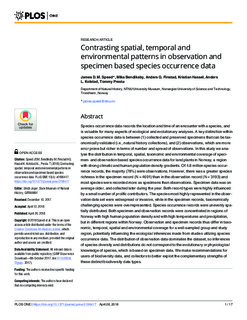| dc.contributor.author | Speed, James David Mervyn | |
| dc.contributor.author | Bendiksby, Mika | |
| dc.contributor.author | Finstad, Anders Gravbrøt | |
| dc.contributor.author | Hassel, Kristian | |
| dc.contributor.author | Kolstad, Anders Lorentzen | |
| dc.contributor.author | Prestø, Tommy | |
| dc.date.accessioned | 2019-02-19T12:03:06Z | |
| dc.date.available | 2019-02-19T12:03:06Z | |
| dc.date.created | 2018-05-14T08:07:15Z | |
| dc.date.issued | 2018 | |
| dc.identifier.citation | PLoS ONE. 2018, 13 (4), . | nb_NO |
| dc.identifier.issn | 1932-6203 | |
| dc.identifier.uri | http://hdl.handle.net/11250/2586245 | |
| dc.description.abstract | Species occurrence data records the location and time of an encounter with a species, and is valuable for many aspects of ecological and evolutionary analyses. A key distinction within species occurrence data is between (1) collected and preserved specimens that can be taxonomically validated (i.e., natural history collections), and (2) observations, which are more error prone but richer in terms of number and spread of observations. In this study we analyse the distribution in temporal, spatial, taxonomic and environmental coverage of specimen- and observation based species occurrence data for land plants in Norway, a region with strong climatic and human population density gradients. Of 4.8 million species occurrence records, the majority (78%) were observations. However, there was a greater species richness in the specimen record (N = 4691) than in the observation record (N = 3193) and most species were recorded more as specimens than observations. Specimen data was on average older, and collected later during the year. Both record types were highly influenced by a small number of prolific contributors. The species most highly represented in the observation data set were widespread or invasive, while in the specimen records, taxonomically challenging species were overrepresented. Species occurrence records were unevenly spatially distributed. Both specimen and observation records were concentrated in regions of Norway with high human population density and with high temperatures and precipitation, but in different regions within Norway. Observation and specimen records thus differ in taxonomic, temporal, spatial and environmental coverage for a well-sampled group and study region, potentially influencing the ecological inferences made from studies utilizing species occurrence data. The distribution of observation data dominates the dataset, so inferences of species diversity and distributions do not correspond to the evolutionary or physiological knowledge of species, which is based on specimen data. We make recommendations for users of biodiversity data, and collectors to better exploit the complementary strengths of these distinct biodiversity data types. | nb_NO |
| dc.language.iso | eng | nb_NO |
| dc.publisher | Public Library of Science | nb_NO |
| dc.rights | Navngivelse 4.0 Internasjonal | * |
| dc.rights.uri | http://creativecommons.org/licenses/by/4.0/deed.no | * |
| dc.title | Contrasting spatial, temporal and environmental patterns in observation and specimen based species occurrence data | nb_NO |
| dc.type | Journal article | nb_NO |
| dc.type | Peer reviewed | nb_NO |
| dc.description.version | publishedVersion | nb_NO |
| dc.source.pagenumber | 17 | nb_NO |
| dc.source.volume | 13 | nb_NO |
| dc.source.journal | PLoS ONE | nb_NO |
| dc.source.issue | 4 | nb_NO |
| dc.identifier.doi | 10.1371/journal.pone.0196417 | |
| dc.identifier.cristin | 1584754 | |
| dc.description.localcode | © 2018 Speed et al. This is an open access article distributed under the terms of the Creative Commons Attribution License, which permits unrestricte d use, distribu tion, and reproduction in any medium, provided the original author and source are credited. | nb_NO |
| cristin.unitcode | 194,31,10,0 | |
| cristin.unitname | Institutt for naturhistorie | |
| cristin.ispublished | true | |
| cristin.fulltext | original | |
| cristin.qualitycode | 1 | |

